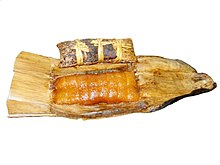
Akumaki (あくまき, 灰汁巻き) is a Japanese-style confection, or wagashi made in Kagoshima, Miyazaki, and Kumamoto Prefecture during the Boys’ Festival on May 5.[1][2] It is more widely called chimaki in Japan, and are similar to, and historically originate from, Chinese zongzi, traditionally eaten during the Dragon boat festival.[3]
Preparation and consumption[edit]
Akumaki is made by soaking glutinous rice wrapped in bamboo leaves in lye overnight. Because it's slightly bitter, it's typically eaten with blended sugar and toasted soybean flour (kinako), with a little salt or soaked in honey. It has an unusual flavor and is considered an acquired taste.
History[edit]
It is said that akumaki began as a long-term provision for samurai during the Battle of Sekigahara (1600) or the Japanese invasions of Korea (1592–1598). Also, Saigō Takamori (1821–1877) took akumaki as a nonperishable commodity to the battlefield during the Satsuma Rebellion (1877). Akumaki became popular in the north of Miyazaki Prefecture and Kumamoto Prefecture due to that rebellion.
Storage and distribution[edit]
It can be kept for about one week at normal temperature, for about two weeks in a refrigerator, and can also be frozen. Vacuum-packed akumaki can be found in many places as a souvenir, but it is usually a homemade confection. Recently, since the opening of the Kyushu Shinkansen train line, akumaki has attracted considerable attention as a slow food.[clarification needed] Akumaki is sold in hotels of Kagoshima, roadside stations (michi no eki), over the internet and in supermarkets throughout Kagoshima prefecture.
See also[edit]
References[edit]
- ^ "菓子類・その他". Kagoshima Prefecture. 2010-01-13. Archived from the original on 13 January 2010. Retrieved 2021-09-24.
- ^ Nawa, Karen Meiko; Ishimura, Shinnichi (2004-11-17). "A Study on Japanese Traditional Sweets Wrapped in Natural Materials: The Relationship Between Japanese Contemporary Package Design and the Japanese Wrapping Culture". DRS Biennial Conference Series.
- ^ "Chimaki (ちまき)". Food in Japan.